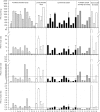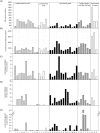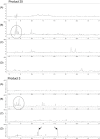Screening for anti-nutritional compounds in complementary foods and food aid products for infants and young children
- PMID: 23167584
- PMCID: PMC6860611
- DOI: 10.1111/j.1740-8709.2012.00449.x
Screening for anti-nutritional compounds in complementary foods and food aid products for infants and young children
Abstract
A range of compounds with negative nutritional impact - 'anti-nutrients' - are found in most plant foods. The contents of anti-nutrients in processed foods depend on the ingredients and processing. Anti-nutrients in complementary foods for children can have a negative impact on nutritional status. The aim of this study was to screen complementary foods from developing countries for the anti-nutritional compounds, phytate, polyphenols, inhibitors of trypsin and chymotrypsin, and lectins. Commercial products based on whole grain cereals were included as a 'worst-case' scenario for anti-nutrient exposure in Europe. Contents of minerals (iron, zinc and calcium), in which absorption or utilisation is affected by anti-nutrients, were analysed. Thirty-six products representing foods used in food aid programmes, local blended foods, fortified instant porridges and 'baby foods' were analysed. The content of minerals indicated that the fortification of a number of products did not meet the declared levels of iron, zinc and calcium. The phytate content ranged from 68 to 1536 mg/100 g, confirming a persistent problem of high levels of phytate in processed cereal- and legume-based products. The phytate : Fe molar ratio exceeded the recommended level of <1.0 in 32 of the 36 products. The total polyphenols varied from 1.3 to 9.3 mg gentisic acid equivalents g(-1) . Screening low-molecular weight soluble polyphenols may be more relevant in complementary foods than total polyphenolic compounds. Trypsin and chymotrypsin inhibitors and lectins were found in residual amounts in most products, indicating efficient degradation by heat processing. However, young infants and malnourished children may have reduced pancreatic function, and upper limits for residual trypsin inhibitors are needed.
© 2012 Blackwell Publishing Ltd.
Conflict of interest statement
All authors of this paper have declared to have no conflicts of interest in the present study.
Figures



Similar articles
-
A review of phytate, iron, zinc, and calcium concentrations in plant-based complementary foods used in low-income countries and implications for bioavailability.Food Nutr Bull. 2010 Jun;31(2 Suppl):S134-46. doi: 10.1177/15648265100312S206. Food Nutr Bull. 2010. PMID: 20715598 Review.
-
Sweetpotato-based complementary food would be less inhibitory on mineral absorption than a maize-based infant food assessed by compositional analysis.Int J Food Sci Nutr. 2012 Dec;63(8):957-63. doi: 10.3109/09637486.2012.687368. Epub 2012 May 18. Int J Food Sci Nutr. 2012. PMID: 22594854
-
Phytate, calcium, iron, and zinc contents and their molar ratios in foods commonly consumed in China.J Agric Food Chem. 2005 Dec 28;53(26):10285-90. doi: 10.1021/jf052051r. J Agric Food Chem. 2005. PMID: 16366728
-
Complementary feeding and effect of spontaneous fermentation on anti-nutritional factors of selected cereal-based complementary foods.BMC Pediatr. 2018 Dec 23;18(1):394. doi: 10.1186/s12887-018-1369-3. BMC Pediatr. 2018. PMID: 30579346 Free PMC article.
-
Implications of phytate in plant-based foods for iron and zinc bioavailability, setting dietary requirements, and formulating programs and policies.Nutr Rev. 2018 Nov 1;76(11):793-804. doi: 10.1093/nutrit/nuy028. Nutr Rev. 2018. PMID: 30010865 Review.
Cited by
-
Adequacy of Some Locally Produced Complementary Foods Marketed in Benin, Burkina Faso, Ghana, and Senegal.Nutrients. 2018 Jun 18;10(6):785. doi: 10.3390/nu10060785. Nutrients. 2018. PMID: 29912154 Free PMC article.
-
Maternal and Infant Supplementation with Small-Quantity Lipid-Based Nutrient Supplements Increases Infants' Iron Status at 18 Months of Age in a Semiurban Setting in Ghana: A Secondary Outcome Analysis of the iLiNS-DYAD Randomized Controlled Trial.J Nutr. 2019 Jan 1;149(1):149-158. doi: 10.1093/jn/nxy225. J Nutr. 2019. PMID: 30624674 Free PMC article. Clinical Trial.
-
Contextualising complementary feeding in a broader framework for stunting prevention.Matern Child Nutr. 2013 Sep;9 Suppl 2(Suppl 2):27-45. doi: 10.1111/mcn.12088. Matern Child Nutr. 2013. PMID: 24074316 Free PMC article. Review.
-
Enhancing young child nutrition and development in developing countries.Matern Child Nutr. 2013 Jan;9 Suppl 1(Suppl 1):6-11. doi: 10.1111/mcn.12009. Matern Child Nutr. 2013. PMID: 23167581 Free PMC article. No abstract available.
-
Nutritional Quality and Safety of Complementary Foods Developed from Blends of Staple Grains and Honey Bee Larvae (Apis mellifera).Int J Food Sci. 2021 May 10;2021:5581585. doi: 10.1155/2021/5581585. eCollection 2021. Int J Food Sci. 2021. PMID: 34046495 Free PMC article.
References
-
- Agostoni C., Axelsson I., Goulet O., Koletzko B., Michaelsen K.F., Puntis J. et al (2006) Soy protein infant formulae and follow‐on formulae: a commentary by the ESPGHAN Committee on Nutrition. Journal of Pediatric Gastroenterology and Nutrition 42, 352–361. - PubMed
-
- Ajila C.M., Brar S.K., Verma M., Tyagi R.D., Godbout S. & Valero J.R. (2011) Extraction and analysis of polyphenols: recent trends. Critical Reviews in Biotechnology 31, 227–249. - PubMed
-
- Andang'o P.E., Osendarp S.J., Ayah R., West C.E., Mwaniki D.L., De Wolf C.A. et al (2007) Efficacy of iron‐fortified whole maize flour on iron status of schoolchildren in Kenya: a randomised controlled trial. Lancet 369, 1799–1806. - PubMed
-
- Arentoft A.M., Mortensen K. & Sørensen H. (1991) Pea proteinase inhibitor activity. Aspects of Applied Biology 27, 211–215.
-
- Arentoft A.M., Frokiaer H., Michaelsen S., Soerensen H. & Soerensen S. (1993) High‐performance capillary electrophoresis for the determination of trypsin and chymotrypsin inhibitors and their association with trypsin, chymotrypsin and monoclonal‐antibodies. Journal of Chromatography. A 652, 189–198. - PubMed
Publication types
MeSH terms
Substances
LinkOut - more resources
Full Text Sources
Medical

